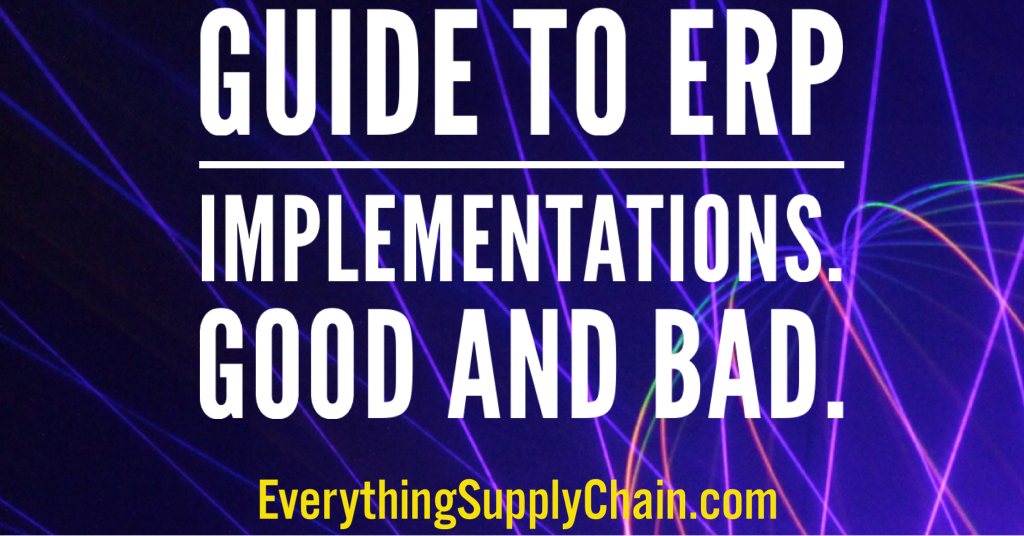Guide to ERP Implementations – The Good and Bad.
Unlock the Secrets of ERP Implementations – Get the Facts Before You Decide.
ERP implementations can be a daunting task for any business. It requires a lot of planning, resources, and time to ensure that the implementation is successful. This guide will provide an overview of the good and bad aspects of ERP implementations. It will discuss the benefits of ERP implementations, the challenges that may arise, and the best practices for successful implementations. It will also provide tips and advice on how to avoid common pitfalls and ensure that the implementation is successful. With this guide, businesses can make informed decisions about their ERP implementations and ensure that they are successful.
How to Prepare for an ERP Implementation Project
An ERP implementation project is a complex undertaking that requires careful planning and preparation. To ensure a successful implementation, it is important to take the time to properly prepare for the project. Here are some tips for preparing for an ERP implementation project:
1. Establish a Project Team: Assemble a team of stakeholders from across the organization to ensure that all areas of the business are represented. This team should include representatives from IT, finance, operations, and other departments.
2. Define Goals and Objectives: Clearly define the goals and objectives of the project. This will help ensure that everyone is on the same page and working towards the same end result.
3. Develop a Project Plan: Create a detailed project plan that outlines the tasks, timeline, and resources needed to complete the project. This plan should include milestones and deadlines to ensure that the project stays on track.
4. Identify Resources: Identify the resources needed to complete the project, such as hardware, software, and personnel. Make sure to include a budget for these resources in the project plan.
5. Train Personnel: Train personnel on the new system to ensure that they are comfortable using it. This will help ensure a smooth transition to the new system.
6. Test the System: Test the system to make sure that it is functioning properly and meets the needs of the organization.
By following these tips, organizations can ensure that they are properly prepared for an ERP implementation project. Taking the time to properly plan and prepare for the project will help ensure a successful implementation.
The Pros and Cons of Cloud-Based ERP Systems
Cloud-based ERP systems are becoming increasingly popular among businesses of all sizes. These systems offer a range of benefits, including cost savings, scalability, and improved data security. However, there are also some potential drawbacks to consider before making the switch.
Pros
Cost Savings: Cloud-based ERP systems are typically more cost-effective than traditional on-premise systems. This is because they require less upfront investment and can be scaled up or down as needed. Additionally, cloud-based systems are often subscription-based, meaning businesses only pay for the services they use.
Scalability: Cloud-based ERP systems are highly scalable, meaning businesses can easily add or remove users and features as needed. This makes them ideal for businesses that are growing or changing rapidly.
Data Security: Cloud-based ERP systems offer improved data security compared to traditional on-premise systems. This is because the data is stored in the cloud, meaning it is protected from physical damage or theft. Additionally, cloud-based systems are often updated regularly, meaning businesses can benefit from the latest security features.
Cons
Reliability: Cloud-based ERP systems are dependent on the reliability of the internet connection. If the connection is lost, businesses may not be able to access their data or use the system.
Data Privacy: Cloud-based ERP systems may not offer the same level of data privacy as traditional on-premise systems. This is because the data is stored in the cloud, meaning it is accessible to the provider.
Vendor Lock-in: Cloud-based ERP systems are often vendor-specific, meaning businesses may be locked into a particular provider. This can make it difficult to switch providers if the business’s needs change.
Overall, cloud-based ERP systems offer a range of benefits, including cost savings, scalability, and improved data security. However, there are also some potential drawbacks to consider before making the switch. Businesses should carefully weigh the pros and cons before deciding if a cloud-based system is right for them.
The Benefits of Customizing Your ERP System
Customizing your Enterprise Resource Planning (ERP) system can provide a number of benefits to your business. An ERP system is a comprehensive software solution that helps organizations manage their business processes, such as accounting, inventory, and customer relationship management. By customizing your ERP system, you can tailor it to meet the specific needs of your business, allowing you to maximize its potential.
One of the primary benefits of customizing your ERP system is improved efficiency. By customizing the system to fit your business’s unique needs, you can streamline processes and reduce the amount of time and effort required to complete tasks. This can help you save time and money, as well as improve customer service.
Customizing your ERP system can also help you improve accuracy. By tailoring the system to your business’s specific needs, you can ensure that data is entered accurately and that reports are generated quickly and accurately. This can help you make better decisions and reduce the risk of errors.
Customizing your ERP system can also help you improve scalability. By customizing the system to fit your business’s current needs, you can ensure that it can grow with your business. This can help you save money in the long run, as you won’t have to invest in a new system as your business grows.
Finally, customizing your ERP system can help you improve security. By tailoring the system to your business’s specific needs, you can ensure that only authorized personnel have access to sensitive data. This can help you protect your business from potential security threats.
Overall, customizing your ERP system can provide a number of benefits to your business. By tailoring the system to your business’s specific needs, you can improve efficiency, accuracy, scalability, and security. This can help you save time and money, as well as improve customer service and protect your business from potential security threats.
The Cost of ERP Implementations
Enterprise resource planning (ERP) systems are complex software solutions that help organizations manage their business processes. They are designed to integrate all aspects of a business, including finance, operations, sales, and customer service. Implementing an ERP system can be a costly endeavor, but the benefits of improved efficiency and cost savings can be significant.
The cost of an ERP implementation depends on a variety of factors, including the size of the organization, the complexity of the system, and the scope of the project. Generally, the cost of an ERP implementation can range from tens of thousands of dollars to millions of dollars.
The cost of an ERP implementation can be broken down into three main categories: software, hardware, and services. Software costs include the cost of the ERP system itself, as well as any additional software that may be needed to integrate the system with existing systems. Hardware costs include the cost of servers, storage, and other hardware needed to run the system. Services costs include the cost of consulting, training, and other services needed to ensure the successful implementation of the system.
In addition to the upfront costs of an ERP implementation, there are also ongoing costs associated with maintaining and updating the system. These costs can include software maintenance fees, hardware upgrades, and additional training and consulting services.
The cost of an ERP implementation can be a significant investment, but the benefits of improved efficiency and cost savings can be well worth the expense. Organizations should carefully consider the costs and benefits of an ERP implementation before making a decision.
How to Choose the Right ERP System for Your Business
Choosing the right Enterprise Resource Planning (ERP) system for your business is an important decision that can have a significant impact on the success of your organization. An ERP system is a comprehensive software solution that integrates all of the core business processes of an organization into a single, unified system. It can help streamline operations, improve efficiency, and reduce costs.
When selecting an ERP system, it is important to consider the size and scope of your business, as well as your specific needs and goals. Here are some key factors to consider when selecting an ERP system:
1. Scalability: An ERP system should be able to grow with your business. Look for a system that can easily scale up or down as your business needs change.
2. Cost: ERP systems can be expensive, so it is important to consider the total cost of ownership. This includes the cost of the software, implementation, training, and ongoing maintenance.
3. Functionality: Make sure the system you choose has the features and functionality you need to support your business processes.
4. Integration: Look for an ERP system that can easily integrate with other systems and applications. This will help ensure that data is shared across the organization and that processes are streamlined.
5. Support: Make sure the vendor you choose offers reliable customer support. This will help ensure that any issues are quickly resolved and that your system is always up and running.
By taking the time to evaluate your needs and research the available options, you can ensure that you select the right ERP system for your business. With the right system in place, you can improve efficiency, reduce costs, and maximize the success of your organization.
The Challenges of ERP Implementations
Enterprise resource planning (ERP) systems are powerful tools that can help organizations streamline their operations and improve efficiency. However, implementing an ERP system can be a complex and challenging process. Here are some of the most common challenges associated with ERP implementations.
1. Cost: ERP systems can be expensive to implement and maintain. Organizations must consider the cost of the software, hardware, and any associated services. Additionally, organizations must factor in the cost of training staff and the time required to implement the system.
2. Complexity: ERP systems are complex and require a significant amount of time and effort to implement. Organizations must ensure that the system is properly configured and integrated with existing systems. Additionally, organizations must ensure that the system is properly tested and that staff are adequately trained to use it.
3. Change Management: Implementing an ERP system requires significant changes to existing processes and procedures. Organizations must ensure that staff are adequately prepared for the changes and that they understand how the new system will affect their work.
4. Data Migration: Migrating data from existing systems to the new ERP system can be a complex and time-consuming process. Organizations must ensure that the data is properly migrated and that the new system is properly configured to handle the data.
5. Security: ERP systems contain sensitive data and must be properly secured. Organizations must ensure that the system is properly configured to protect the data from unauthorized access.
Implementing an ERP system can be a complex and challenging process. Organizations must ensure that they are adequately prepared for the implementation and that they have the resources and expertise necessary to ensure a successful implementation.
The Benefits of ERP Implementations
Enterprise resource planning (ERP) systems are becoming increasingly popular among businesses of all sizes. An ERP system is a comprehensive software solution that integrates all of a company’s core business processes, such as accounting, inventory management, customer relationship management, and human resources. By streamlining these processes, ERP implementations can provide a number of benefits to businesses.
One of the primary advantages of ERP implementations is improved efficiency. By integrating all of a company’s core business processes, an ERP system can help to reduce the amount of time and effort required to complete tasks. This can lead to increased productivity and cost savings. Additionally, ERP systems can help to reduce errors and improve accuracy by automating processes and eliminating manual data entry.
Another benefit of ERP implementations is improved visibility. By providing a single source of truth, an ERP system can give businesses a comprehensive view of their operations. This can help to identify areas of inefficiency and provide insights into how to improve processes. Additionally, ERP systems can provide real-time data, allowing businesses to make more informed decisions.
Finally, ERP implementations can help to improve customer service. By providing a single source of truth, an ERP system can help to ensure that customer data is accurate and up-to-date. This can help to reduce customer service issues and improve customer satisfaction. Additionally, ERP systems can provide insights into customer behavior, allowing businesses to better understand their customers and tailor their services accordingly.
In summary, ERP implementations can provide a number of benefits to businesses. By streamlining processes and providing a single source of truth, ERP systems can help to improve efficiency, visibility, and customer service. As such, ERP implementations can be a valuable tool for businesses of all sizes.
What is ERP and How Can It Help Your Business?
Enterprise Resource Planning (ERP) is a business process management software that allows organizations to manage and integrate their core business processes, such as accounting, inventory, human resources, and customer relationship management. ERP systems are designed to provide a comprehensive view of an organization’s operations, enabling businesses to make better decisions and improve efficiency.
ERP systems can help businesses in a variety of ways. By providing a single, integrated system for managing all of an organization’s core processes, ERP systems can help streamline operations and reduce costs. ERP systems can also provide real-time visibility into an organization’s operations, allowing managers to make more informed decisions. Additionally, ERP systems can help businesses automate processes, such as order processing and invoicing, which can help reduce errors and improve customer service.
Overall, ERP systems can help businesses improve efficiency, reduce costs, and make better decisions. By providing a single, integrated system for managing all of an organization’s core processes, ERP systems can help businesses streamline operations and improve customer service.
Conclusion
In conclusion, ERP implementations can be a great way to streamline business processes and increase efficiency. However, it is important to understand the potential risks and challenges associated with ERP implementations before taking the plunge. By taking the time to research and plan ahead, businesses can ensure that their ERP implementation is successful and beneficial to their organization.
ERP Resources
- AI for Supply Chain | Transform Your Legacy ERP Systems.
- End To End SCM Process
- ERP Quotes by Top Minds.
- Get a Job in SCM.
- Hershey’s ERP Implementation Failure | Supply Chain Issues.
- SAP Quotes by Top Minds.
- SCM Resources by Topic
- Supply Chain Today Website
- The Supply Chain Predictive Enterprise: Where data science meets supply chain.
- Top 10 Warehouse Management Systems | Independent Ranking.
- What is SAP? Why do we need ERP? Beginner Tutorial
Your Guide to the Amazon Supply Chain.
Guide to the Apple Supply Chain.
Guide to the Toyota Supply Chain
Your Guide to Negotiations.
Guide to the Tesla Supply Chain.
Guide to the Automotive Supply Chain












